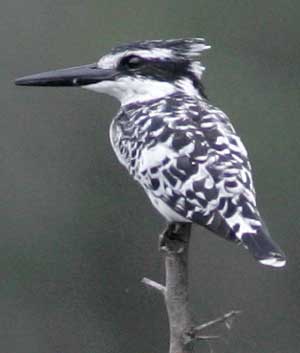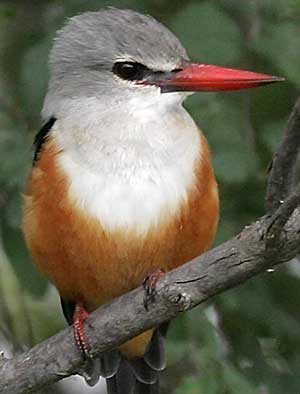Contact Details: Scotch Macaskill, Dirt Road Traders, Currys Post Road, Howick, KwaZulu-Natal, South Africa. Tel: +27 (0)82 578 2329. Privacy: Your privacy is guaranteed. See our Privacy Policy for more. This site accepts advertising and other forms of compensation - see Disclosure and Advertising for details. Site updated: 2022. Copyright © 2002 - 2022 Scotch Macaskill

| ||||||||||
|
||||||||||
|
SEE ALL
|
Kingfishers of Southern Africaby Roddy SmithSome of the most easily recognised birds in Southern Africa are the kingfishers. They fall into the order Coraciiformes and are related to the bee-eaters and rollers. Between them these three groups contain many of our most spectacularly coloured birds. Each group, however, has its own distinctive jizz (jizz being the name birders give to a shape and way of moving that is characteristic of a particular bird or group of birds). Kingfishers are all fairly stocky birds with short necks and relatively long straight bills. Their bills are very similar in shape to those of the much larger herons, possibly because they both evolved for the purpose of stabbing fish.
There are 10 species of kingfisher in Southern Africa and they range in size from the tiny Pygmy Kingfisher at one extreme to — surprise! — the Giant Kingfisher at the other. All the kingfishers are hole-nesters, either in trees or in sand-banks, most are territorial and the same pair may occupy the same nest site for several years. Despite the family name, however, not all catch fish. The fishing kingfishers are the Giant, the Pied, the Half-collared and the tiny Malachite, while the Mangrove Kingfisher eats mostly crabs and other crustaceans. The others all eat insects, although some of them are often seen on river banks. All, to a greater or lesser extent, have bright blue as the most noticeable colour in their plumage, with the notable exceptions of the Giant Kingfisher and Pied Kingfisher, which are the most easily identified species. The most obvious by virtue of its spectacular method of fishing is the Pied Kingfisher. It hovers quite high above the surface of the water, watching for fish. If after a few moments none are seen it moves a short distance and tries again, and as soon as it spies one it folds its wings and plunges like a small feathered harpoon into the water to spear the fish on its sharp beak.
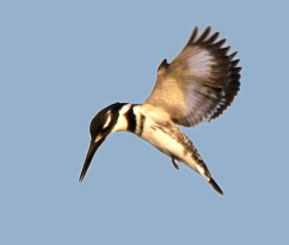
Pied Kingfisher Hovering Pied Kingfishers are also our only gregarious species; they are frequently seen in small groups and the previous year’s young help the parents to rear the current season’s brood. I have also seen Pied Kingfishers pass small fish to each other in mid-air which may be a courting ritual. The Giant Kingfisher also occasionally hovers, but in general it is a sedentary fisherman, watching for fish from a perch in a tree. In size it is not much smaller than a Green-backed Heron, with a similar shape and flight pattern, so it is possible to confuse them when one of the birds takes flight from a distance. The Giant Kingfisher is capable of catching quite large fish, and its loud raucous “kek-kek-kek” is often heard before it is seen. 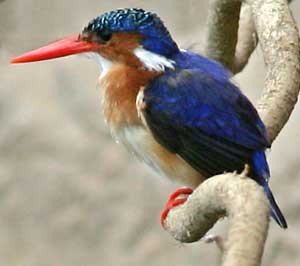
Malachite Kingfisher It has become almost a cliché to refer to the Malachite Kingfisher as "bejewelled", but that is a very apt description of this exquisite little bird. By far the best way to get a good look at one is in a canoe — they tend to sit on reeds or sedges down near the water’s edge and when disturbed take off with their distinctive fast low flight to the next perch. Many people tend to confuse them with the similar Pygmy Kingfishers. The latter have mauve cheeks, but they are most easily distinguished by habitat; the insectivorous Pygmy Kingfisher is seldom found near water, and the Malachite seldom far from it. 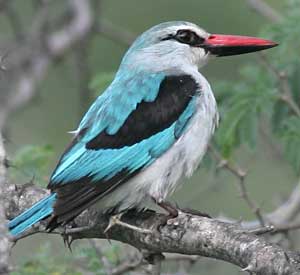
Woodland Kingfisher The same thing applies to two other pairs of species. Woodland Kingfishers, intra-African migrants whose loud pleasant trilling call can be heard in woodland areas towards the end of the dry season as they stake their territories, very closely resemble Mangrove Kingfishers. The Woodland Kingfisher has a two-coloured bill, but in any case they are unlikely to be confused because the one lives in woodland and the other lives — another surprise — in coastal forest and mangrove swamps. Also very similar in appearance are our two least brightly-coloured kingfishers (and the two whose names are not particularly apt), the Brown-hooded and the Striped. Again, the Striped Kingfisher has a two-coloured bill, but it is also the least aquatic of our Southern African kingfishers and is usually found in dry country well away from water (I have seen it in the Zambezi Valley but nowhere near the river) whereas the Brown-hooded is usually close to water. The final two Southern African species are very distinctive and cannot be confused with any others in the region. The Half-collared is a fishing species which is surprisingly not seen much on the Lower Zambezi; the dapper Grey-headed (previously Grey-hooded, and also sometimes called the Chestnut-bellied) is common there in the summer months although rare in most of Southern Africa.
Roddy Smith is a wildlife conservationist and safari guide based in the Lower Zambezi National Park, Zambia. Images © Scotch Macaskill Return to Wildlife Articles |
|||||||||
|
|
||||||||||

